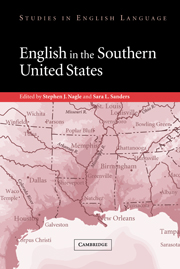Book contents
- Frontmatter
- Contents
- Notes on the contributors
- Acknowledgments
- Introduction
- 1 The origins of Southern American English
- 2 Shakespeare in the coves and hollows? Toward a history of Southern English
- 3 Eight grammatical features of southern United States speech present in early modern London prison narratives
- 4 The shared ancestry of African-American and American-White Southern Englishes: some speculations dictated by history
- 5 The complex grammatical history of African-American and white vernaculars in the South
- 6 Grammatical features of southern speech: yall, might could, and fixin to
- 7 Sounding southern: a look at the phonology of English in the South
- 8 Vowel shifting in the southern states
- 9 Enclave dialect communities in the South
- 10 Urbanization and the evolution of Southern American English
- 11 The Englishes of southern Louisiana
- 12 Features and uses of southern style
- References
- Index
9 - Enclave dialect communities in the South
Published online by Cambridge University Press: 22 September 2009
- Frontmatter
- Contents
- Notes on the contributors
- Acknowledgments
- Introduction
- 1 The origins of Southern American English
- 2 Shakespeare in the coves and hollows? Toward a history of Southern English
- 3 Eight grammatical features of southern United States speech present in early modern London prison narratives
- 4 The shared ancestry of African-American and American-White Southern Englishes: some speculations dictated by history
- 5 The complex grammatical history of African-American and white vernaculars in the South
- 6 Grammatical features of southern speech: yall, might could, and fixin to
- 7 Sounding southern: a look at the phonology of English in the South
- 8 Vowel shifting in the southern states
- 9 Enclave dialect communities in the South
- 10 Urbanization and the evolution of Southern American English
- 11 The Englishes of southern Louisiana
- 12 Features and uses of southern style
- References
- Index
Summary
Introduction
Contrary to the popular stereotype, there is great dialect diversity within the speech folkways of the regional South. No situation is more reflective of this diversity than the so-called dialect enclave, in which a speech community has been historically disconnected from the wider sociospatial, dominant population groups in the region. There are a number of these situations in the Mid-Atlantic and South, located in areas that range from the islands off of the Atlantic coast to the inland highland regions of Appalachia. Although such dialect situations have always been of interest to dialectologists, their significance seems to have heightened over the past couple of decades.
Dialect enclaves have now been considered as a primary database for the reconstruction of prominent vernacular varieties in the United States, based on the assumption that linguistic change will be conservative and that these dialects will remain relatively immune to changes diffusing throughout the wider population. Enclave varieties of English might thus provide a window into the earlier structure of evolving vernacular varieties such as Appalachian Vernacular English (Montgomery 1989b; Montgomery and Hall forthcoming) and African-American Vernacular English (AAVE) (Poplack 1999; Poplack and Sankoff 1987; Poplack and Tagliamonte 1989, 1991, 2000). In fact, transplant enclave communities of African Americans have provided essential spoken-language evidence for revising the historical reconstruction of AAVE over the past couple of decades.
Another reason for the recent interest in dialect enclaves is related to the moribund status of some of these varieties.
- Type
- Chapter
- Information
- English in the Southern United States , pp. 141 - 158Publisher: Cambridge University PressPrint publication year: 2003
- 3
- Cited by



